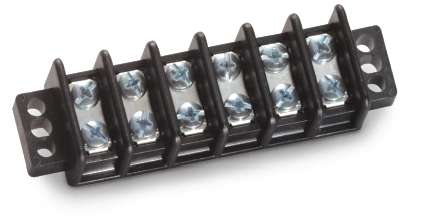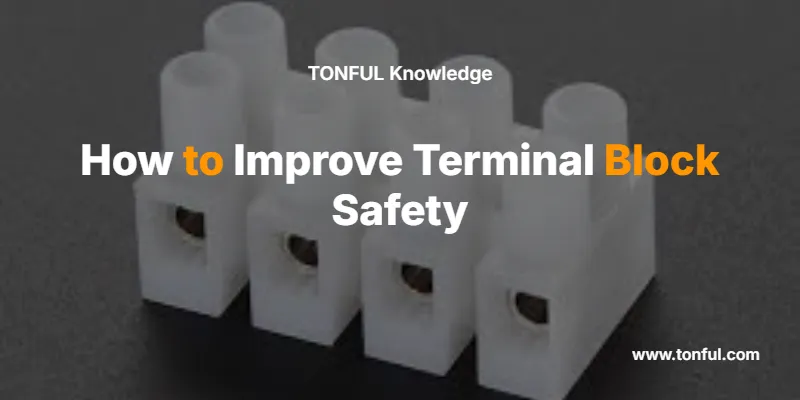Terminal block safety improvement involves implementing proper installation techniques, using appropriate protection devices, ensuring correct wire sizing, maintaining adequate spacing, and following established electrical codes. The most critical safety measures include using proper torque specifications, installing arc fault protection, selecting UL-listed components, and maintaining proper conductor insulation ratings.
What Are Terminal Blocks and Why Safety Matters

Terminal blocks are electrical connection points that allow multiple wires to be joined together safely and securely. They serve as junction points in electrical systems, enabling technicians to connect, disconnect, and troubleshoot circuits without permanent wire splicing.
Key safety concerns with terminal blocks include:
- Electrical arcing and fire hazards
- Shock and electrocution risks
- Equipment damage from loose connections
- Code violations leading to inspection failures
- Insurance and liability issues
Essential Terminal Block Safety Improvements
1. Proper Installation Techniques
Torque Specifications
- Always use manufacturer-specified torque values
- Under-torquing creates loose connections and arcing
- Over-torquing can damage terminals and strip threads
- Use calibrated torque screwdrivers for critical applications
Wire Preparation
- Strip conductors to exact manufacturer specifications
- Avoid nicking or damaging wire strands
- Use proper wire strippers for clean cuts
- Ensure no loose strands extend beyond terminals
2. Protection Device Integration
| Protection Type | Function | Application |
|---|---|---|
| Arc Fault Circuit Interrupters (AFCI) | Detect dangerous arcing conditions | Branch circuits and feeders |
| Ground Fault Circuit Interrupters (GFCI) | Protect against shock hazards | Wet locations and equipment |
| Overcurrent Protection | Prevent wire overheating | All terminal block circuits |
| Surge Protection Devices (SPD) | Guard against voltage spikes | Sensitive electronic loads |
3. Environmental Protection
Enclosure Requirements
- Select appropriate NEMA ratings for installation environment
- Use dust-tight enclosures in contaminated areas
- Install weatherproof housings for outdoor applications
- Ensure proper ingress protection (IP) ratings
Temperature Considerations
- Verify terminal block temperature ratings exceed ambient conditions
- Account for heat generated by electrical loads
- Provide adequate ventilation in confined spaces
- Use high-temperature terminals for demanding applications
Key Differences Between Terminal Block Safety Standards
UL vs. IEC Standards Comparison
| Standard | Origin | Key Features | Applications |
|---|---|---|---|
| UL 1059 | United States | Stringent fire safety requirements | North American installations |
| IEC 60947-7-1 | International | Global harmonization focus | International projects |
| CSA C22.2 No. 158 | Canada | Cold weather performance | Canadian installations |
Safety Classification Levels
Pollution Degree Classifications:
- Pollution Degree 1: Clean environments with no contamination
- Pollution Degree 2: Normal industrial environments with occasional contamination
- Pollution Degree 3: Heavy contamination from dust, moisture, or chemicals
- Pollution Degree 4: Permanent contamination creating conductive paths
How to Choose the Right Safety Features
Critical Selection Criteria
1. Current and Voltage Ratings
- Always derate by 20% for safety margins
- Account for inrush current conditions
- Verify voltage ratings exceed system requirements
- Consider altitude derating requirements
2. Material and Construction
- Choose flame-retardant housing materials
- Select corrosion-resistant contact materials
- Verify mechanical strength requirements
- Ensure UV resistance for outdoor applications
3. Code Compliance Requirements
| Code | Requirement | Safety Impact |
|---|---|---|
| NEC Article 110.14 | Connection integrity | Prevents loose connections |
| NEC Article 314 | Box fill calculations | Avoids overcrowding |
| UL 489 | Circuit breaker compatibility | Ensures proper protection |
| IEEE 1202 | Flame propagation limits | Fire safety compliance |
Expert Tip: Always consult local electrical codes and AHJs (Authorities Having Jurisdiction) before installation. What’s acceptable in one location may violate codes in another.
Step-by-Step Safety Installation Process
Phase 1: Pre-Installation Safety Check
- Turn off power at the main breaker and verify with voltage tester
- Lock out/tag out (LOTO) the electrical panel
- Test your voltage tester on a known energized source
- Inspect all tools and equipment for damage
- Review installation drawings and specifications
Phase 2: Terminal Block Installation
- Mount terminal blocks in appropriate enclosures
- Verify proper spacing according to manufacturer specifications
- Install identification labels before wiring
- Check torque wrench calibration
- Route conductors to minimize stress on terminals
Phase 3: Connection and Testing
- Strip conductors to exact specifications
- Insert wires fully into terminal blocks
- Torque connections to manufacturer specifications
- Perform insulation resistance testing
- Conduct final visual inspection
Safety Warning: Never work on energized terminal blocks. Always verify zero energy state before beginning work.
Common Safety Problems and Solutions
Problem 1: Loose Connections
Symptoms:
- Overheating terminals
- Arcing or sparking
- Intermittent electrical faults
- Burning odors
Solutions:
- Use calibrated torque tools
- Follow manufacturer torque specifications
- Implement regular inspection schedules
- Train personnel on proper techniques
Problem 2: Overcrowding
Symptoms:
- Difficulty accessing terminals
- Inadequate spacing violations
- Heat buildup in enclosures
- Code compliance failures
Solutions:
- Calculate box fill requirements
- Use larger enclosures when necessary
- Install multiple smaller terminal blocks
- Implement proper wire management
Problem 3: Environmental Contamination
Symptoms:
- Corrosion on terminals
- Insulation breakdown
- Ground faults
- Reduced service life
Solutions:
- Select appropriate NEMA ratings
- Use sealed terminal blocks
- Implement regular cleaning schedules
- Apply protective coatings when approved
Advanced Safety Features and Technologies
Smart Terminal Block Systems
Benefits:
- Real-time monitoring of connection integrity
- Automatic fault detection and reporting
- Predictive maintenance capabilities
- Integration with building management systems
Applications:
- Critical infrastructure facilities
- High-value industrial processes
- Life safety systems
- Remote monitoring requirements
Arc Fault Protection Integration
Modern terminal block designs incorporate advanced arc fault detection:
- Series arc detection for damaged conductors
- Parallel arc detection for insulation failures
- Ground arc detection for safety hazards
- Combination protection for comprehensive coverage
Professional Recommendations and Best Practices
Maintenance Schedule Requirements
| Inspection Type | Frequency | Focus Areas |
|---|---|---|
| Visual inspection | Monthly | Signs of overheating or damage |
| Torque verification | Annually | Critical connections |
| Thermographic survey | Annually | Hot spot identification |
| Insulation testing | Every 3 years | System integrity verification |
When to Call a Professional
Immediate professional help required for:
- Arc flash hazard assessments
- Short circuit coordination studies
- Code compliance verification
- Complex protection system design
Safety Warning: Arc flash incidents can cause severe burns or death. Always use proper PPE and follow NFPA 70E requirements when working on electrical systems.
Quick Reference Safety Checklist
Pre-Installation Safety Verification
- Power locked out and tagged
- Voltage verified as zero
- Tools inspected and calibrated
- PPE appropriate for hazard level
- Permits and approvals obtained
Installation Quality Control
- Terminal blocks UL listed
- Torque specifications followed
- Proper conductor sizing verified
- Spacing requirements met
- Environmental rating appropriate
Final Testing and Commissioning
- Insulation resistance tested
- Ground fault protection verified
- Arc fault protection operational
- Documentation completed
- Personnel training conducted
Frequently Asked Questions
What torque specifications should I use for terminal blocks?
Always follow the manufacturer’s specifications exactly. Typical values range from 7-10 inch-pounds for small terminals to 35-50 inch-pounds for large power terminals. Using incorrect torque is the leading cause of terminal block failures.
How often should terminal blocks be inspected?
Visual inspections should occur monthly, with detailed annual inspections including torque verification and thermographic scanning. Critical applications may require more frequent inspection.
Can I use aluminum wire with any terminal block?
Only use aluminum conductors with terminal blocks specifically rated and listed for aluminum wire. Most standard terminal blocks are copper-only. Always verify compatibility to prevent galvanic corrosion.
What’s the difference between finger-safe and non-finger-safe terminals?
Finger-safe (IP20) terminal blocks prevent accidental contact with live parts when properly installed. They’re required in many applications where personnel access is possible. Non-finger-safe terminals require additional protection barriers.
How do I calculate proper spacing between terminal blocks?
Follow manufacturer minimum spacing requirements, typically 6mm for standard applications. High-voltage applications require greater spacing based on voltage levels and pollution degree classifications.
What environmental rating do I need for outdoor installations?
Outdoor terminal blocks typically require NEMA 4X or IP66 rating minimum. Consider UV resistance, temperature cycling, and local climate conditions when selecting appropriate protection levels.
When is arc fault protection required for terminal blocks?
Arc fault protection requirements depend on local electrical codes and application. AFCI protection is increasingly required for branch circuits and is highly recommended for critical applications regardless of code requirements.
Can I mix different terminal block brands in the same installation?
While technically possible, mixing brands can create maintenance and compatibility issues. Use consistent brands and models throughout installations for optimal safety and serviceability.
Conclusion: Building Safer Electrical Systems
Improving terminal block safety requires a comprehensive approach combining proper product selection, installation techniques, protection devices, and maintenance practices. The key to long-term safety lies in understanding that terminal blocks are critical system components deserving the same attention as major electrical equipment.
Remember that electrical safety is never optional—it’s a professional and legal requirement. When in doubt, consult with qualified electrical professionals who can provide expert guidance tailored to your specific application and local code requirements.
By implementing these safety improvements systematically, you’ll create more reliable electrical systems, reduce maintenance costs, prevent dangerous failures, and most importantly, protect people and property from electrical hazards.

